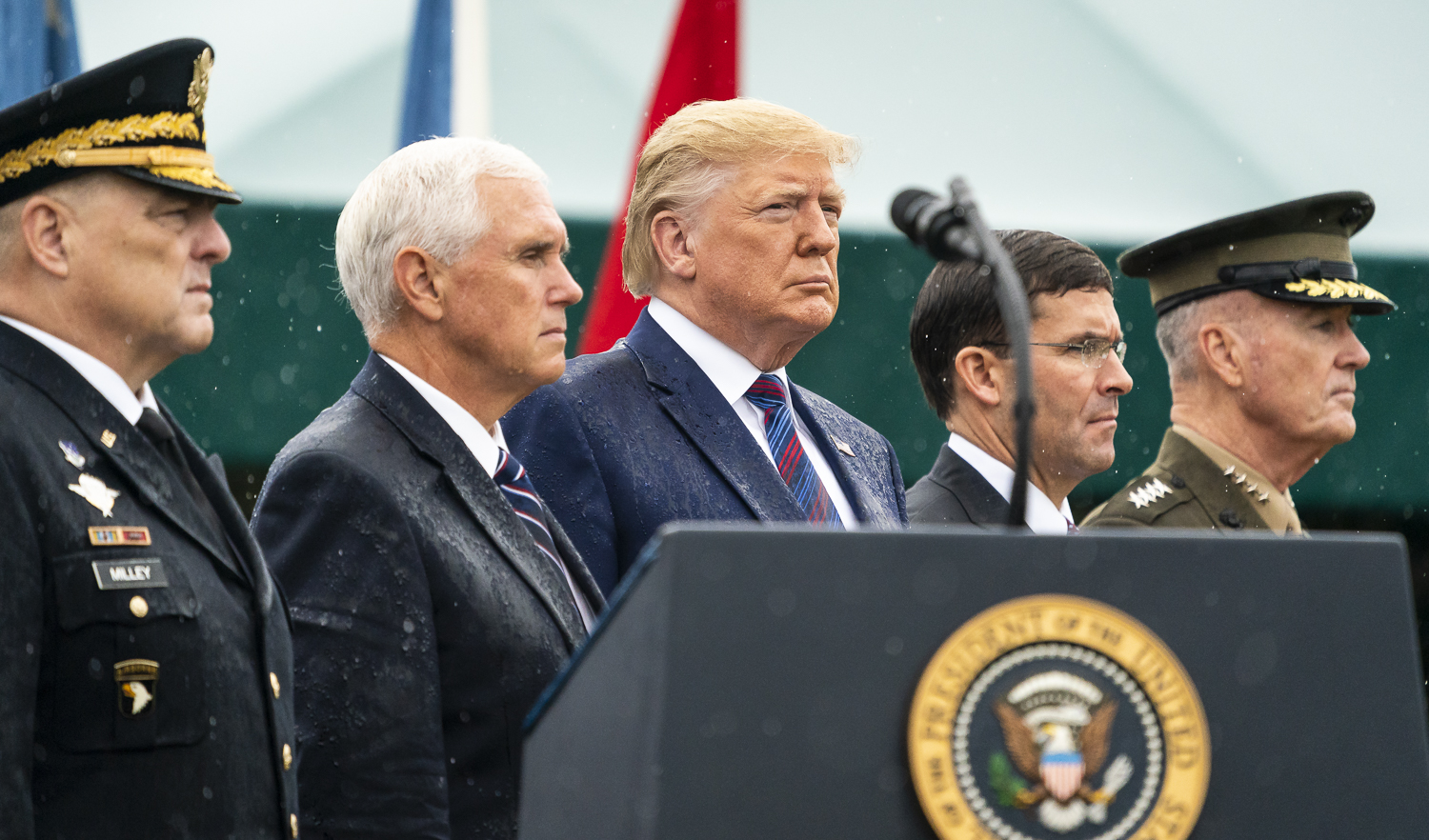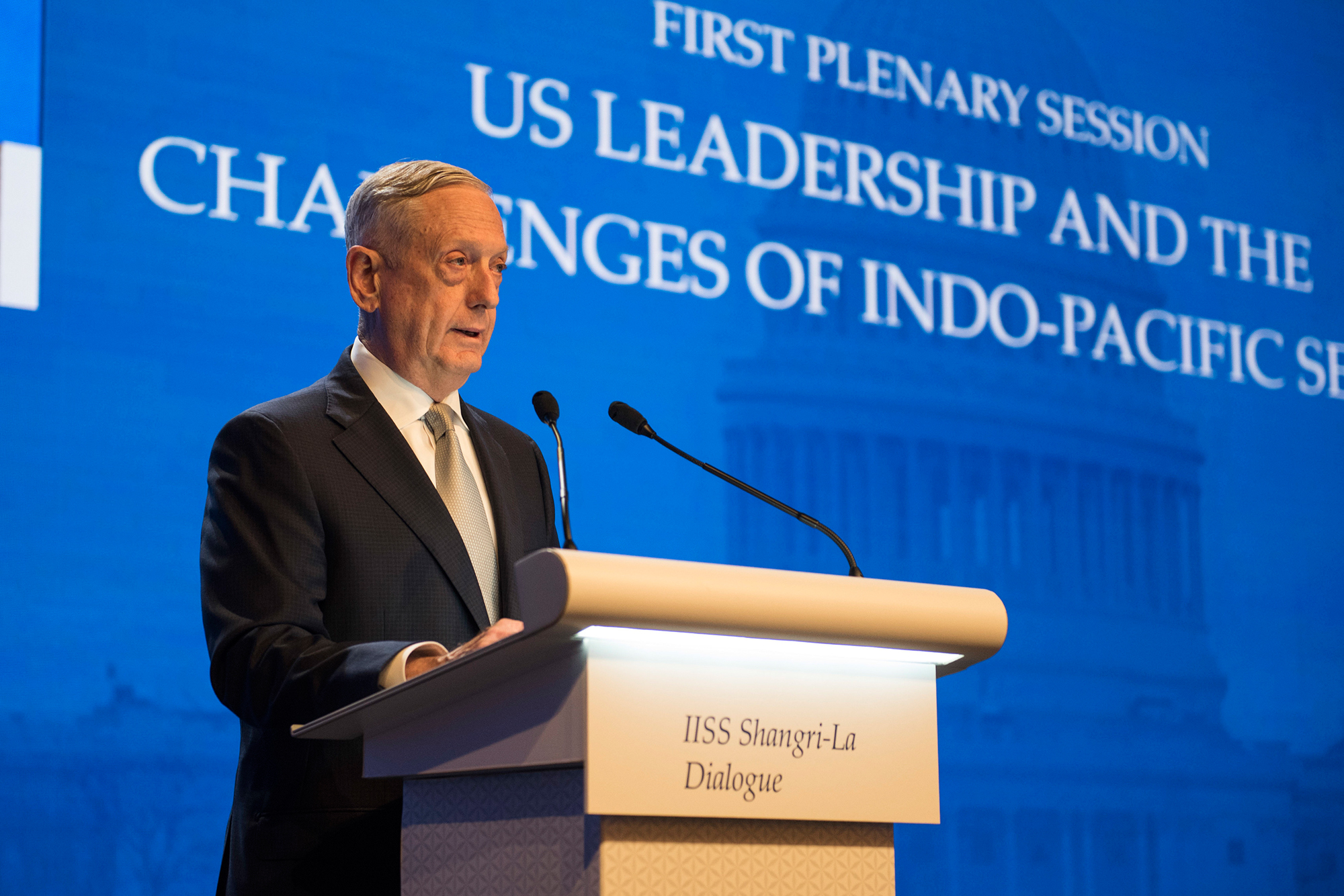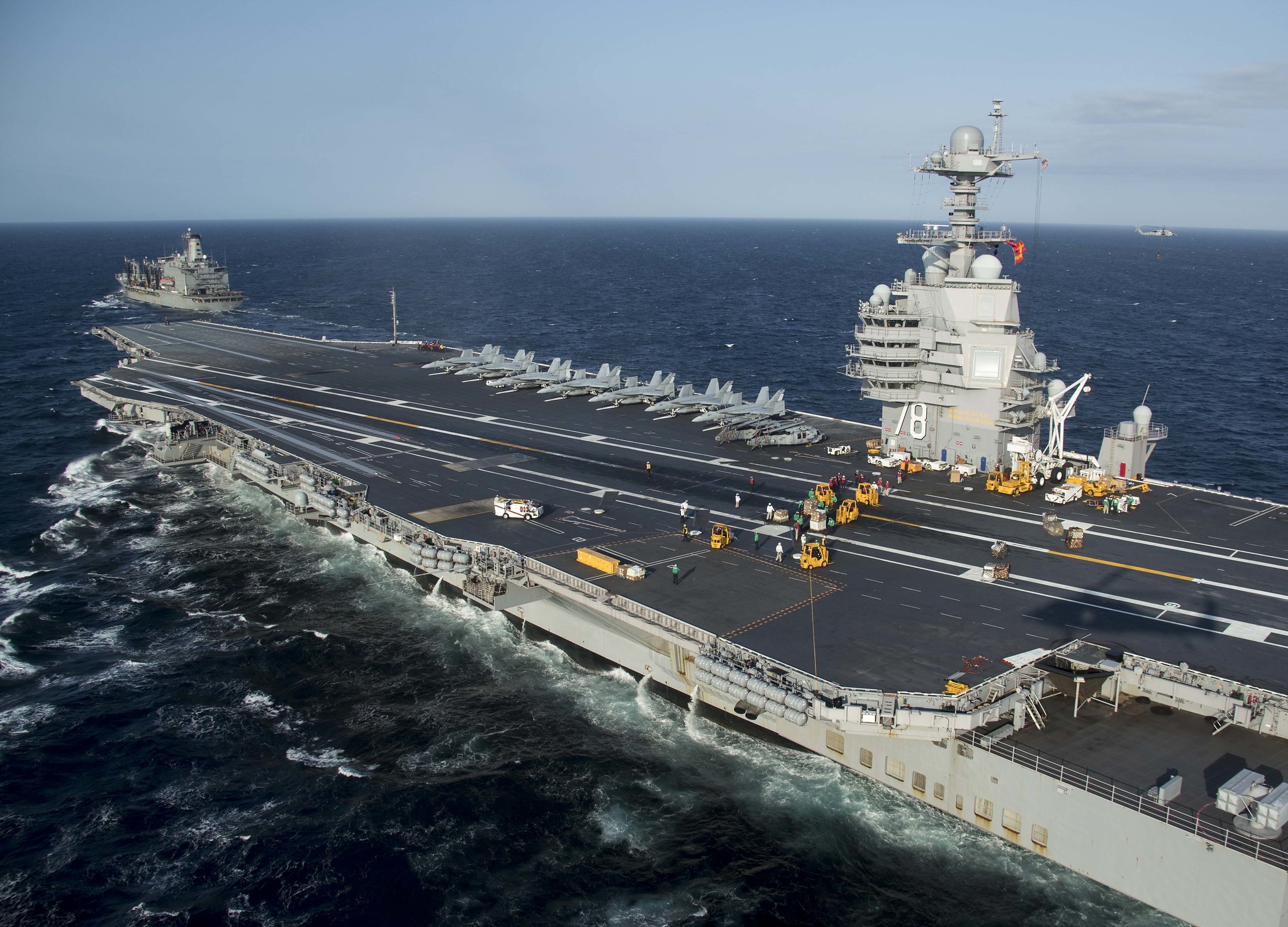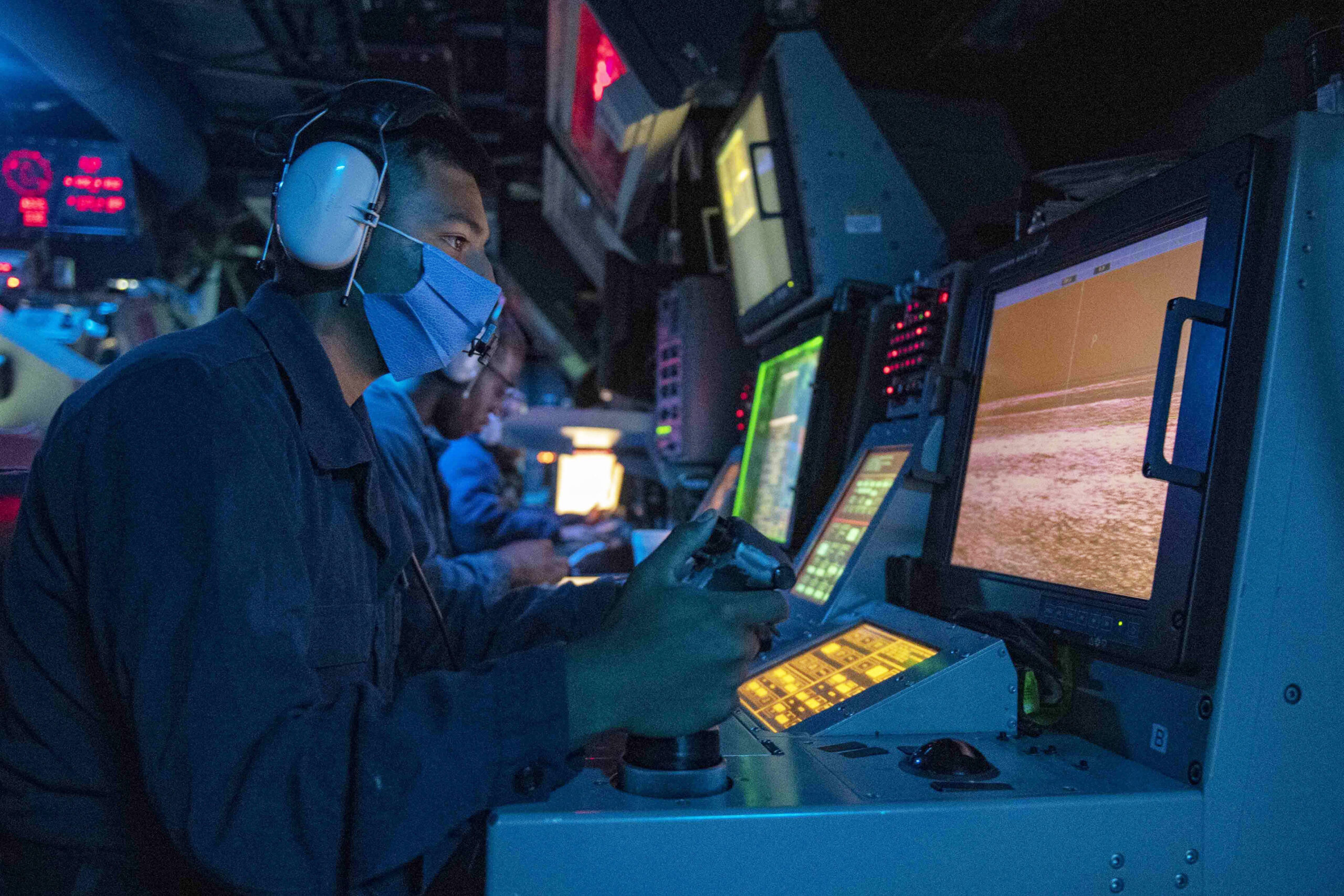Michael Klare says it’s impossible to overstate the significance of the Pentagon’s shift in posture during the term of the outgoing president.

President Donald Trump, center, during welcome ceremony for 20th chairman of the Joint Chiefs of Staff at Joint Base Myer-Henderson Hall, Virginia, Sept. 30, 2019. (White House, D. Myles Cullen)
By Michael T. Klare
TomDispatch.com
 In the military realm, Donald Trump will most likely be remembered for his insistence on ending America’s involvement in its 21st-century “forever wars” — the fruitless, relentless, mind-crushing military campaigns undertaken by Presidents George W. Bush and Barack Obama in Afghanistan, Iraq, Syria and Somalia.
In the military realm, Donald Trump will most likely be remembered for his insistence on ending America’s involvement in its 21st-century “forever wars” — the fruitless, relentless, mind-crushing military campaigns undertaken by Presidents George W. Bush and Barack Obama in Afghanistan, Iraq, Syria and Somalia.
After all, as a candidate, Trump pledged to bring U.S. troops home from those dreaded war zones and, in his last days in office, he’s been promising to get at least most of the way to that objective. The president’s fixation on this issue (and the opposition of his own generals and other officials on the subject) has generated a fair amount of media coverage and endeared him to his isolationist supporters.
Yet, however newsworthy it may be, this focus on Trump’s belated troop withdrawals obscures a far more significant aspect of his military legacy: the conversion of the U.S. military from a global counter-terror force into one designed to fight an all-out, cataclysmic, potentially nuclear war with China and/or Russia.
People seldom notice that Trump’s approach to military policy has always been two-faced. Even as he repeatedly denounced the failure of his predecessors to abandon those endless counterinsurgency wars, he bemoaned their alleged neglect of America’s regular armed forces and promised to spend whatever it took to “restore” their fighting strength.
“In a Trump administration,” he declared in a September 2016 campaign speech on national security, America’s military priorities would be reversed, with a withdrawal from the “endless wars we are caught in now” and the restoration of “our unquestioned military strength.”
Please Contribute to Consortium News During its 2020 Winter Fund Drive
Once in office, he acted to implement that very agenda, instructing his surrogates — a succession of national security advisers and secretaries of defense — to commence U.S. troop withdrawals from Iraq and Afghanistan (though he agreed for a time to increase troop levels in Afghanistan), while submitting ever-mounting defense budgets.
The Pentagon’s annual spending authority climbed every year between 2016 and 2020, rising from $580 billion at the start of his administration to $713 billion at the end, with much of that increment directed to the procurement of advanced weaponry. Additional billions were incorporated into the Department of Energy budget for the acquisition of new nuclear weapons and the full-scale “modernization” of the country’s nuclear arsenal.
Far more important than that increase in arms spending, however, was the shift in strategy that went with it. The military posture President Trump inherited from the Obama administration was focused on fighting the Global War on Terror (GWOT), a grueling, never-ending struggle to identify, track, and destroy anti-Western zealots in far-flung areas of Asia, Africa and the Middle East.
The posture he’s bequeathing to Joe Biden is almost entirely focused on defeating China and Russia in future “high-end” conflicts waged directly against those two countries — fighting that would undoubtedly involve high-tech conventional weapons on a staggering scale and could easily trigger nuclear war.
From the GWOT to the GPC
It’s impossible to overstate the significance of the Pentagon’s shift from a strategy aimed at fighting relatively small bands of militants to one aimed at fighting the military forces of China and Russia on the peripheries of Eurasia.
The first entailed the deployment of scattered bands of infantry and Special Operations Forces units backed by patrolling aircraft and missile-armed drones; the other envisions the commitment of multiple aircraft carriers, fighter squadrons, nuclear-capable bombers, and brigade-strength armored divisions.
Similarly, in the GWOT years, it was generally assumed that U.S. troops would face adversaries largely armed with light infantry weapons and homemade bombs, not, as in any future war with China or Russia, an enemy equipped with advanced tanks, planes, missiles, ships, and a full range of nuclear munitions.

U.S. soldier collects biometric data in Badula Qulp, Helmand province, Afghanistan, Feb. 21, 2010. (U.S. Air Force, Efren Lopez, Flickr)
This shift in outlook from counterterrorism to what, in these years, has come to be known in Washington as “great power competition,” or GPC, was first officially articulated in the Pentagon’s National Security Strategy of February 2018.
“The central challenge to U.S. prosperity and security,” it insisted, “is the reemergence of long-term, strategic competition by what the National Security Strategy classifies as revisionist powers,” a catchphrase for China and Russia. (It used those rare italics to emphasize just how significant this was.)
For the Department of Defense and the military services, this meant only one thing: from that moment on, so much of what they did would be aimed at preparing to fight and defeat China and/or Russia in high-intensity conflict.
As Secretary of Defense Jim Mattis put it to the Senate Armed Services Committee that April,
“The 2018 National Defense Strategy provides clear strategic direction for America’s military to reclaim an era of strategic purpose… Although the Department continues to prosecute the campaign against terrorists, long-term strategic competition — not terrorism —is now the primary focus of U.S. national security.”

Secretary of Defense Jim Mattis in 2018. (U.S. Navy, Joshua Fulton)
This being the case, Mattis added, America’s armed forces would have to be completely re-equipped with new weaponry intended for high-intensity combat against well-armed adversaries.
“Our military remains capable, but our competitive edge has eroded in every domain of warfare,” he noted. “The combination of rapidly changing technology [and] the negative impact on military readiness resulting from the longest continuous period of combat in our nation’s history [has] created an overstretched and under-resourced military.” In response, we must “accelerate modernization programs in a sustained effort to solidify our competitive advantage.”
In that same testimony, Mattis laid out the procurement priorities that have since governed planning as the military seeks to “solidify” its competitive advantage.
First comes the “modernization” of the nation’s nuclear weapons capabilities, including its nuclear command-control-and-communications systems; then, the expansion of the Navy through the acquisition of startling numbers of additional surface ships and submarines, along with the modernization of the Air Force, through the accelerated procurement of advanced combat planes; finally, to ensure the country’s military superiority for decades to come, vastly increased investment in emerging technologies like artificial intelligence, robotics, hyper-sonics, and cyber warfare.
“During the Trump years, the notion that nuclear arms could be used as ordinary weapons of war in future great-power conflicts took deep root in Pentagon thinking and erasing it will prove to be no easy feat.”
These priorities have by now been hard-wired into the military budget and govern Pentagon planning. Last February, when submitting its proposed budget for fiscal year (FY) 2021, for example, the Department of Defense asserted,
“The FY 2021 budget supports the irreversible implementation of the National Defense Strategy (NDS), which drives the Department’s decision-making in reprioritizing resources and shifting investments to prepare for a potential future, high-end fight.”
This nightmarish vision, in other words, is the military future that Trump will leave to the Biden administration.
Navy in the Lead
From the very beginning, Donald Trump has emphasized the expansion of the Navy as an overriding objective. “When Ronald Reagan left office, our Navy had 592 ships… Today, the Navy has just 276 ships,” he lamented in that 2016 campaign speech. One of his first priorities as president, he asserted, would be to restore its strength. “We will build a Navy of 350 surface ships and submarines,” he promised.
Once in office, the “350-ship Navy” (later increased to 355 ships) became a mantra.
In emphasizing a big Navy, Trump was influenced to some degree by the sheer spectacle of large modern warships, especially aircraft carriers with their scores of combat planes.
“Our carriers are the centerpiece of American military might overseas,” he insisted while visiting the nearly completed carrier, the USS Gerald R. Ford, in March 2017. “We are standing here today on four-and-a-half acres of combat power and sovereign U.S. territory, the likes of which there is nothing… there is no competition to this ship.”

The USS Gerald R. Ford aircraft carrier pulls alongside a replenishment oiler in the Atlantic Ocean, May 15, 2020. (U.S. Navy, Ruben Reed)
Not surprisingly, top Pentagon officials embraced the president’s big-Navy vision with undisguised enthusiasm. The reason: they view China as their No. 1 adversary and believe that any future conflict with that country will largely be fought from the Pacific Ocean and nearby seas — that being the only practical way to concentrate U.S. firepower against China’s increasingly built-up coastal defenses.
Then-Secretary of Defense Mark T. Esper expressed this outlook well when, in September, he deemed Beijing the Pentagon’s “top strategic competitor” and the Indo-Pacific region its “priority theater” in planning for future wars.
The waters of that region, he suggested, represent “the epicenter of great power competition with China” and so were witnessing increasingly provocative behavior by Chinese air and naval units. In the face of such destabilizing activity, “the United States must be ready to deter conflict and, if necessary, fight and win at sea.”
In that address, Esper made it clear that the U.S. Navy remains vastly superior to its Chinese counterpart. Nonetheless, he asserted, “We must stay ahead; we must retain our overmatch; and we will keep building modern ships to ensure we remain the world’s greatest Navy.”
Although Trump fired Esper on Nov. 9 for, among other things, resisting White House demands to speed up the withdrawal of American troops from Iraq and Afghanistan, the former defense secretary’s focus on fighting China from the Pacific and adjacent seas remains deeply embedded in Pentagon strategic thinking and will be a legacy of the Trump years.
In support of such a policy, billions of dollars have already been committed to the construction of new surface ships and submarines, ensuring that such a legacy will persist for years, if not decades to come.
Do Like Patton: Strike Deep, Strike Hard

General George Patton in welcome-home parade in Los Angeles, June 9, 1945. (Office of War Information, Wikimedia Commons)
Trump said little about what should be done for U.S. ground forces during the 2016 campaign, except to indicate that he wanted them even bigger and better equipped. What he did do, however, was speak of his admiration for World War II Army generals known for their aggressive battle tactics.
“I was a fan of Douglas MacArthur. I was a fan of George Patton,” he told Maggie Haberman and David Sanger of The New York Times that March. “If we had Douglas MacArthur today or if we had George Patton today and if we had a president that would let them do their thing you wouldn’t have ISIS, okay?”
Trump’s reverence for General Patton has proven especially suggestive in a new era of great-power competition, as U.S. and NATO forces again prepare to face well-equipped land armies on the continent of Europe, much as they did during World War II.
Back then, it was the tank corps of Nazi Germany that Patton’s own tanks confronted on the Western Front. Today, U.S. and NATO forces face Russia’s best-equipped armies in Eastern Europe along a line stretching from the Baltic republics and Poland in the north to Romania in the south.
If a war with Russia were to break out, much of the fighting would likely occur along this line, with main-force units from both sides engaged in head-on, high-intensity combat.

West Berliner with hammer and chisel at the Wall, Nov. 13, 1989. (Joe Lauria)
Since the Cold War ended in 1991 with the implosion of the Soviet Union, American strategists had devoted little serious thought to high-intensity ground combat against a well-equipped adversary in Europe. Now, with East-West tensions rising and U.S. forces again facing well-armed potential foes in what increasingly looks like a military-driven version of the Cold War, that problem is receiving far more attention.
This time around, however, U.S. forces face a very different combat environment. In the Cold War years, Western strategists generally imagined a contest of brute strength in which our tanks and artillery would battle theirs along hundreds of miles of front lines until one side or the other was thoroughly depleted and had no choice but to sue for peace (or ignite a global nuclear catastrophe).
Today’s strategists, however, imagine far more multidimensional (or “multi-domain”) warfare extending to the air and well into rear areas, as well as into space and cyberspace.
In such an environment, they’ve come to believe that the victor will have to act swiftly, delivering paralyzing blows to what they call the enemy’s C3I capabilities (critical command, control, communications, and intelligence) in a matter of days, or even hours. Only then would powerful armored units be able to strike deep into enemy territory and, in true Patton fashion, ensure a Russian defeat.
The U.S. military has labeled such a strategy “all-domain warfare” and assumes that the U.S. will indeed dominate space, cyberspace, airspace, and the electromagnetic spectrum.
In a future confrontation with Russian forces in Europe, as the doctrine lays it out, U.S. air power would seek control of the airspace above the battlefield, while using guided missiles to knock out Russian radar systems, missile batteries, and their C3I facilities.
The Army would conduct similar strikes using a new generation of long-range artillery systems and ballistic missiles. Only when Russia’s defensive capabilities were thoroughly degraded would that Army follow up with a ground assault, Patton-style.
Be Prepared to Fight with Nukes

Standing watch over the optical-sighting-system in the combat information center as the guided missile destroyer USS Mustin conducts routine operations in the Taiwan Strait, Aug. 18, 2020. (U.S. Navy, Cody Beam)
As imagined by senior Pentagon strategists, any future conflict with China or Russia is likely to entail intense, all-out combat on the ground, at sea, and in the air aimed at destroying an enemy’s critical military infrastructure in the first hours or, at most, days of battle, opening the way for a swift U.S. invasion of enemy territory.
This sounds like a winning strategy — but only if you possess all the advantages in weaponry and technology.
If not, what then? This is the quandary faced by Chinese and Russian strategists whose forces don’t quite match up to the power of the American ones.
While their own war planning remains, to date, a mystery, it’s hard not to imagine that the Chinese and Russian equivalents of the Pentagon high command are pondering the possibility of a nuclear response to any all-out American assault on their militaries and territories.
The examination of available Russian military literature has led some Western analysts to conclude that the Russians are indeed increasing their reliance on “tactical” nuclear weapons to obliterate superior U.S./NATO forces before an invasion of their country could be mounted (much as, in the previous century, U.S. forces relied on just such weaponry to avert a possible Soviet invasion of Western Europe).
Russian military analysts have indeed published articles exploring just such an option — sometimes described by the phrase “escalate to de-escalate” (a misnomer if ever there was one) — although Russian military officials have never openly discussed such tactics.
Still, the Trump administration has cited that unofficial literature as evidence of Russian plans to employ tactical nukes in a future East-West confrontation and used it to justify the acquisition of new U.S. weapons of just this sort.
“Russian strategy and doctrine… mistakenly assesses that the threat of nuclear escalation or actual first use of nuclear weapons would serve to ‘de-escalate’ a conflict on terms favorable to Russia,” the administration’s Nuclear Posture Review of 2018 asserts.
“To correct any Russian misperceptions of advantage… the president must have a range of limited and graduated [nuclear] options, including a variety of delivery systems and explosive yields.”
In furtherance of such a policy, that review called for the introduction of two new types of nuclear munitions: a “low-yield” warhead (meaning it could, say, pulverize Lower Manhattan without destroying all of New York City) for a Trident submarine-launched ballistic missile and a new nuclear-armed sea-launched cruise missile.
As in so many of the developments described above, this Trump initiative will prove difficult to reverse in the Biden years.
After all, the first W76-2 low-yield warheads have already rolled off the assembly lines, been installed on missiles, and are now deployed on Trident submarines at sea. These could presumably be removed from service and decommissioned, but this has rarely occurred in recent military history and, to do so, a new president would have to go against his own military high command.
Even more difficult would be to negate the strategic rationale behind their deployment. During the Trump years, the notion that nuclear arms could be used as ordinary weapons of war in future great-power conflicts took deep root in Pentagon thinking and erasing it will prove to be no easy feat.
Amid arguments over the withdrawal of American forces from Afghanistan, Iraq, Syria, and Somalia, amid the firings and sudden replacements of civilian leaders at the Pentagon, Donald Trump’s most significant legacy — the one that could lead not to yet more forever wars but to a forever disaster — has passed almost unnoticed in the media and in political circles in Washington.
Supporters of the new administration and even members of Biden’s immediate circle (though not his actual appointees to national security posts) have advanced some stirring ideas about transforming American military policy, including reducing the role military force plays in America’s foreign relations and redeploying some military funds to other purposes like fighting Covid-19.
Such ideas are to be welcomed, but President Biden’s top priority in the military area should be to focus on the true Trump military legacy — the one that has set us on a war course in relation to China and Russia — and do everything in his power to steer us in a safer, more prudent direction.
Otherwise, the phrase “forever war” could gain a new, far grimmer meaning.
Michael T. Klare, a TomDispatch regular, is the five-college professor emeritus of peace and world security studies at Hampshire College and a senior visiting fellow at the Arms Control Association. He is the author of 15 books, the latest of which is All Hell Breaking Loose: The Pentagon’s Perspective on Climate Change (Metropolitan Books).
This article is from TomDispatch.com.
The views expressed are solely those of the author and may or may not reflect those of Consortium News.
Please Contribute to Consortium News During its 2020 Winter Fund Drive
Donate securely with
Click on ‘Return to PayPal’ here.
Or securely by credit card or check by clicking the red button:



The true US military budget is currently $1,134 billion.
Nagorno-Karabakh demonstrated that the next wars will be fought with drones. The US may be able to field a lot but it will also have to protect its own mainland.
To add to what Daniel said, on different grounds – this is an awful article because it does not address the superiority of certain Russian and Chinese weapon systems, e.g. hypersonic missiles, the carrier-killer DF21D and DF26, all under an umbrella of air defences and electronic warfare. The wave of cruise missiles launched at Syria in 2017 by the USA were mostly spoofed or shot down. BY Syria. The Russians and Chinese undoubtedly have much better defences. The F35 is the worst warplane in history – and this is supposed to penetrate these defences? There’s plenty on sites like southfront or written by Andrei Martyanov to give you an idea about what would happen. BTW Michael, what about logistics? How would the US ship reinforcements over the Atlantic in the face of a barrage of antishipping missiles from air, land, sea surface and submarines?
“this is an awful article because it does not address the superiority of certain Russian and Chinese weapon systems, e.g. hypersonic missiles, …”
Actually, the imperialist mindset is always to overestimate one’s own capabilities while underestimating the opponents’. And quite often such ramblings tend to look like a person playing chess with himself/herself. It might be instructive for readers to dig up the opinions expressed in various American media before the Korean and Vietnam Wars and see how much real events tallied with the predictions.
As far as conventional weapons are concerned, it might be less dangerous if the Russians and the Chinese are convinced that they’ve enough to prevent the kind of bombings the North Koreans experienced during the Korean War. Otherwise we might be seeing nuclear missiles raining on our cities within the first hours of any conflict. It’s unlikely that the Chinese would honor their no-first-use policy if their country is threatened with total destruction. As for the Russians they wouldn’t even think of such a policy.
Can a Star Wars defense prevent nuclear missiles from reaching the US? Anyone believing that might as well believe in the tooth fairy.
Anyway, what will happen will happen: not point worrying over things we cannot prevent. I’d rather spend time waiting for Caitlin Johnstone’s next stimulating article.
Michael Klare has consistently written against the folly of US aggression and militarism.
Absolutely good points to raise. Besides M. Klare still writes about America increasing aircraft carriers and ballistic missiles when these have either become highly vulnerable floating-ducks or totally irrelevant in the age of hypersonics-based air and maritime defenses.
“this is an awful article because it does not address the superiority of certain Russian and Chinese weapon systems, e.g. hypersonic missiles, …”
Actually, the imperialist mindset is always to overestimate one’s own capabilities while underestimating the opponents’. And quite often such ramblings tend to look like a person playing chess with himself/herself. It might be instructive for readers to dig up the opinions expressed in various American media before the Korean and Vietnam Wars and see how much real events tallied with the predictions.
As far as conventional weapons are concerned, it might be less dangerous if the Russians and the Chinese are convinced that they’ve enough to prevent the kind of bombings the North Koreans experienced during the Korean War. Otherwise we might be seeing nuclear missiles raining on our cities within the first hours of any conflict. It’s unlikely that the Chinese would honor their no-first-use policy if their country is threatened with total destruction. As for the Russians they wouldn’t even think of such a policy.
Can a Star Wars defense prevent nuclear missiles from reaching the US? Anyone believing that might as well believe in the tooth fairy.
I’m fairly certain that coming war will be started by Russia. Because they will not wait for US/NATO first strike, they will strike first when intelligence suggest that us strike is imminent. They will start with tactical nukes and destroy all the us bases in Europe. Then proposal will be made. At the same time, China will have amphibious forces on Taiwan beaches and bombed/blocked out US bases in Asia.
The US will be left without troops in Europe and have to choose between all in nuclear war or surrender.
Mr. Klare surely is aware of the document ca.2000 by the Project for the New American Century (PNAC) “Rebuilding America’s Defenses.” Turns out is was a script that almost immediately went into motion. That document spelled out every turn of the evolution of US militarism in this new century, including the conclusion that the US military must be sufficient to fight and win not just one major theatre war but several simultaneously. The avarice and fanaticism of the arms/defense industry is large enough to consume all US “treasure.”
It was the Obama administration that announced the “pivot to Asia” after all, and this was but a sequence of the script to conjure what was only then written: a major theatre war. Before that, under the pretext of the shock to the body politic of 9/11, the US against the world meme took firm hold, and now we hardly blink and eye as more and more trillions are thrown into the pyre.
The point is that the trajectory of US policy and actions has remained remarkably undisturbed since ca.2001. Increasingly militaristic and aggressive despite overwhelming evidence of the failure or counterproductivity of those actions. The US wishes to continue to dictate terms on all fronts since that has become the manner to which we have become accustomed. We were the main beneficiary of the ALLIED victory last century and in a position then to dictate terms. That era is passed, or is passing. We should realize our new place as just one center of power, influence, and prosperity among several. There is no shame in that, and humanity’s survival demands it.
We have yet to live up to our claims of greatness and exceptionalism, and we will never convince others of either at the point of a gun. There lies only death and destruction, national suicide, and possibly the end of life on this planet. The Power Of Pride – yep.
I agree entirely with Daniel. Trump was a weak president who proved unable to stand up to the intelligence agencies or the Pentagon. To blame him for Obama’s trillion dollar nuclear upgrade or the W76-2 is absurd.
The push for war with Russia and China is bipartisan.
This is pure madness. This is transforming minor local conflicts on the borders of Eurasia into world threatening events. This is out of proportion. Neither Russia nor China is a threat to continental America or Europe. Of course they are visible on the world oceans, but the oceans are not US exclusive territories. The US is it own foe as far as I can see. Why not be friends instead. I have been in China for nearly five months in 2012. I never made as many friends elsewhere even here in Canada. How can North Americans know anything of China if they don’ live there for some time? During the five months I have been there I saw no one from NA. I didn’t go to the popular tourist areas of course. Fear comes from the lack of actual knowledge. And military buildups are a sign of fear. Is fear the dominant characteristic of America? It would be very sad.
The US has been “on a war course in relationship to China and Russia” for a number of years. There seems very little awareness of this. So Michael Klare’s article is timely. For my own small contribution to this debate, search: never forget the ghosts of history – wordpress
America is just frightening today.
And it does seem that what it expects and demands from the world can only lead to war.
America’s power establishment knows, although it won’t openly say so, that America is not competitive over a broad range of economic activities.
Many aspects of Trump’s hybrid economic war against China implicitly recognize that fact, as in its arbitrary and illegal treatment of Chinese companies.
The same may be said of its gigantic new national enterprise in laying illegal sanctions against countries doing what it doesn’t like, even though they are doing nothing wrong. American sanction are American laws applied with absolutely no authority against the interests of people who are not Americans.
They represent a daily exercise of hostility as surely as firing shots at the border.
America’s establishment refuses to give up on its claim to primacy in the world, even if it cannot compete and achieve that position naturally, as it very much cannot.
It refuses to adopt a model of cooperation and healthy competition with others.
Even its allies are increasingly treated as subordinates rather than partners, being told what they may buy and where.
Given the realities of China and Russia – increasingly brought closer together by America’s attitudes and demands – it is hard to be very optimistic.
Those realities include their being ancient civilizations which cannot be humiliated and possessing, uniquely in the world the capacity literally to obliterate the United States.
Neither of those societies demands a unique place or treatment, and both call the other states with which they work, partners. They both expect to receive only the respect they earn and no more.
I should add Iran, an ancient and proud civilization that the United States has treated horribly for decades just because it is large and it is in the Middle East. It, too, is being driven into close ties with China and Russia, and Iran is a very resourceful and able society, as it has proved under more than forty years of American hostility and duress.
And of course, the more America spends on weapons, and it already spends unholy amounts, the more the danger of war. It is a fact of history that huge standing militaries work against peace and increase risks. But America’s establishment does not care about peace. It cares about primacy.
John Chuckman is right on with his statements here. Every since the discovery of nuclear weapons allowed the establishment to create a secret arm of the government, they claimed the secrecy was needed to ensure the security of Americans armaments, Americans controlling forces, the super rich, the political power brokers have been pulling the wool over the sheep’s eyes.
Our government is supposed to work for us, we the people, however America’s would be dictators have been firmly in control since they killed JFK. Y’all can get tired and weary of hearing this but it is a fact.
I would make one change to your last sentence Mr. Chuckman i.e. the this addition. It cares about money. The with the most is the superior in their world.
Thanks CN
With respect, this was an awful pick of an article to appear here, as the writer reveals his willful partisanship with phrases like the following:
‘ Amid arguments over the withdrawal of American forces from Afghanistan, Iraq, Syria, and Somalia, amid the firings and sudden replacements of civilian leaders at the Pentagon, Donald Trump’s most significant legacy — the one that could lead not to yet more forever wars but to a forever disaster — has passed almost unnoticed in the media and in political circles in Washington.’ This is because all in media and political circles are fully on board with this. The writer knows this. Yet he acts as if this and other shifts in military focus can somehow be laid at Trump’s feet alone.
The writer knows that all presidents participate and eventually support what the military says is ‘necessary’ and that very few change course from the constant violence Empire requires to thrive. To believe that Trump is somehow uniquely responsible for the recent shifts in the trajectory of our military is partisan hackery.